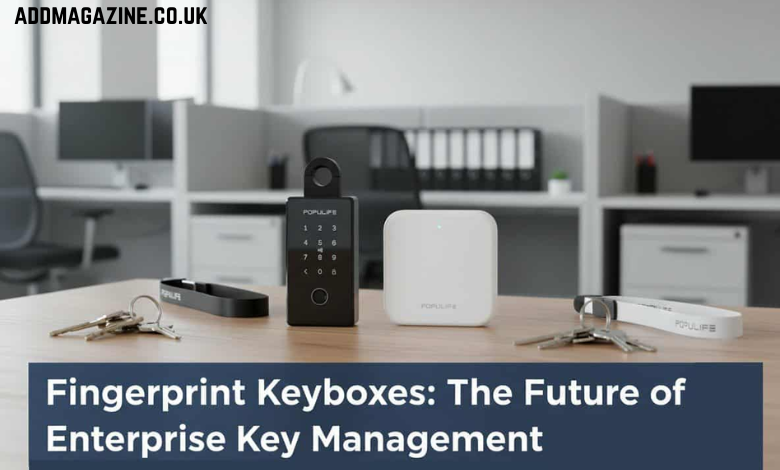In today’s rapidly evolving business landscape, organizations face mounting challenges in managing physical access to their facilities, assets, and sensitive areas. Traditional key management systemsrelying on physical keys, master key systems, and manual trackinghave become increasingly inadequate for modern enterprises.
Enter fingerprint keyboxes: an innovative solution that combines biometric security with smart technology to revolutionize how businesses manage keys and access control. This comprehensive guide explores why fingerprint keyboxes represent the future of enterprise key management and how they’re transforming organizational security protocols.
The Evolution of Enterprise Key Management
For decades, businesses have struggled with the complexities of physical key management. Lost keys create security vulnerabilities, rekeying locks proves expensive, and tracking who accessed what and when remains nearly impossible with traditional systems. Property managers, facility operators, and business owners have long searched for more efficient, secure, and accountable solutions.
The digital revolution has finally reached physical access control. Fingerprint keyboxes merge cutting-edge biometric technology with smart connectivity, offering enterprises unprecedented control over their key management systems. These devices serve as intelligent gatekeepers, storing physical keys securely while employing advanced fingerprint recognition to grant access only to authorized personnel.
Understanding Fingerprint Keybox Technology
Fingerprint keyboxes are sophisticated devices that store physical keys, keycards, or small valuable items while restricting access through biometric authentication. Unlike traditional lockboxes that rely on combination codes or physical keys, these smart devices use advanced fingerprint recognition technology to verify user identity before granting access.
Modern fingerprint keyboxes integrate multiple security layers and unlock methods, typically including fingerprint scanning, NFC (Near Field Communication), Bluetooth connectivity, PIN codes, and mobile app control. This multi-modal approach ensures accessibility while maintaining robust security standards that meet enterprise requirements.
The technology operates through sophisticated biometric sensors that map unique fingerprint patterns, creating encrypted digital templates stored securely within the device. When a user places their finger on the scanner, the system compares the scan against stored templates in milliseconds, granting or denying access based on authentication results.
Key Features Driving Enterprise Adoption
Advanced Biometric Security
The primary advantage of fingerprint keyboxes lies in their biometric authentication capability. Fingerprints are unique to each individual and cannot be easily duplicated, lost, or shared like traditional keys or PIN codes. This inherent security makes fingerprint authentication ideal for enterprises handling sensitive materials or operating in regulated industries.
Remote Authorization and Management
Modern fingerprint keyboxes support remote user authorization through dedicated mobile applications. Administrators can grant or revoke access from anywhere globally, eliminating the need for physical presence during user enrollment. This remote capability proves invaluable for businesses with multiple locations, property managers overseeing numerous sites, or organizations requiring rapid access changes.
When connected to gateway devices, these keyboxes enable real-time management including remote temporary password generation, instant user addition or removal, and comprehensive access logging—all controlled through intuitive smartphone applications.
Multiple Permission Levels
Enterprise-grade fingerprint keyboxes offer sophisticated permission management with various access levels:
Permanent Access: Ideal for full-time employees, facility managers, or executives who require ongoing access without time restrictions. These users can access keys anytime without administrative intervention.
Time-Limited Access: Perfect for contractors, temporary staff, or scheduled maintenance personnel. Administrators can set specific time windows during which access remains active, with automatic deactivation when the period expires. This feature also supports recurring access schedules, accommodating shift workers or regular service providers.
One-Time Access: Designed for delivery personnel, emergency responders, or occasional visitors requiring single-use access. These credentials automatically burn after first use, eliminating security risks associated with forgotten access revocation.
Comprehensive Access Methods
While fingerprint recognition serves as the primary authentication method, enterprise keyboxes typically support multiple unlock mechanisms:
- Fingerprint scanning for regular users
- NFC cards or tags for backup access or users preferring card-based systems
- Bluetooth unlocking through mobile devices for proximity-based access
- PIN codes including permanent, time-limited, one-time, and custom passwords
- Remote unlock via mobile application for emergency situations
This flexibility ensures operational continuity even if one authentication method becomes temporarily unavailable.
Enterprise Applications and Use Cases
Property Management and Real Estate
Property management companies overseeing multiple buildings face constant challenges coordinating access for maintenance crews, contractors, and prospective tenants. Fingerprint keyboxes eliminate the need for physical key handoffs, allowing property managers to grant time-limited access remotely and track exactly who accessed which properties and when.
For showing vacant units, agents can receive one-time access codes without requiring keys from the main office. Maintenance requests become more efficient as service personnel can be granted immediate access to specific units without interrupting property managers.
Short-Term Rental Operations
Airbnb hosts, vacation rental managers, and serviced apartment operators benefit enormously from fingerprint keybox technology. Guest check-ins become seamless with remotely generated access codes valid only during reservation periods. Cleaning staff receive recurring time-limited access aligned with turnover schedules, while property inspectors get occasional access without requiring permanent credentials.
The system’s ability to generate access codes without requiring internet connectivity on the device itself proves particularly valuable, as administrators can create valid codes from anywhere globally using proprietary algorithm technology.
Corporate Facilities and Offices
Businesses with sensitive areas—server rooms, executive offices, research labs, or inventory storage—require robust access control with detailed audit trails. Fingerprint keyboxes provide both security and accountability, logging every access attempt with timestamps and user identification.
Companies can issue different access levels to various employee tiers, contractors can receive temporary credentials that automatically expire, and emergency access can be granted remotely when needed. The elimination of physical key distribution reduces administrative overhead while enhancing security.
Fleet and Equipment Management
Organizations managing vehicle fleets or expensive equipment face challenges securing keys while allowing authorized personnel access. Fingerprint keyboxes mounted at facilities provide secure key storage with comprehensive tracking of who accessed which vehicle keys and when.
Car rental companies can grant customers time-limited access to retrieve vehicle keys, eliminating staffing requirements for key handoffs. Construction companies can ensure only certified operators access keys to specific heavy machinery.
Technical Advantages for Enterprise Deployment
Weather Resistance and Durability
Enterprise-grade fingerprint keyboxes feature all-weather construction suitable for outdoor installation. Operating temperature ranges typically span from -25°C to 55°C (-13°F to 131°F), ensuring reliable performance in diverse climates. Marine-grade materials and coastal-resistant designs protect against humidity, salt air, and temperature extremes.
Extended Battery Life
Unlike continuously connected electronic locks, fingerprint keyboxes employ power-efficient technology that extends battery life significantly. Standard configurations using four AAA alkaline batteries typically support up to 20,000 lock/unlock operations—approximately 24 months of regular use. Low battery warnings alert administrators before power depletion, preventing access disruptions.
Scalable Storage Capacity
Modern fingerprint keyboxes accommodate substantial storage needs, typically holding up to 6 physical keys, 30+ keycards, or other small valuable items. This spacious design makes single devices suitable for managing multiple access points or storing various credentials.
Additionally, these systems can store up to 300 unique and valid passcodes simultaneously. When codes expire or are deleted, new quotas become available, allowing infinite passcode generation over the device’s lifetime.
API Integration Capabilities
Forward-thinking enterprises require systems that integrate with existing infrastructure. Advanced fingerprint keybox solutions offer SaaS platforms with open API integration, allowing seamless connection to property management systems, access control platforms, or custom business applications. This integration streamlines workflows, reduces data entry errors, and centralizes management across multiple security systems.
Installation and Deployment Simplicity
Traditional access control systems require professional installation, door modifications, and significant downtime. Fingerprint keyboxes revolutionize deployment with tool-free installation requiring mere seconds. Devices can be hung directly on doorknobs using specialized shackles that fit various door handle types, mounted on walls adjacent to doors, or attached to fences and gates.
This installation flexibility eliminates drilling requirements, preserves door integrity, and allows rapid deployment across multiple locations. Organizations can scale their access control systems quickly without capital-intensive construction projects or specialized contractors.
Security and Compliance Benefits
Audit Trail and Accountability
Every access event generates a detailed log entry capturing user identity, access method, timestamp, and success or failure status. These comprehensive audit trails meet regulatory compliance requirements in industries like healthcare, finance, and government contracting where access documentation is mandatory.
Administrators can review access histories to investigate security incidents, verify contractor presence, or demonstrate compliance during audits. The elimination of shared keys and PINs ensures individual accountability impossible with traditional systems.
Rapid Access Revocation
When employees terminate, contractors complete projects, or security breaches occur, enterprises must immediately revoke access. With fingerprint keyboxes, administrators delete user credentials instantly from remote locations, eliminating risks associated with unreturned physical keys or unchanged combination codes.
This immediate revocation capability dramatically reduces security windows of vulnerability compared to traditional rekeying procedures that might take days or weeks to complete across multiple facilities.
Cost-Effectiveness and ROI
While fingerprint keyboxes represent upfront investment, their total cost of ownership typically proves lower than traditional key management systems:
- Eliminated rekeying costs when keys are lost or employees terminate
- Reduced administrative labor managing physical key inventories and distributions
- Prevented security breaches resulting from untracked key copies or lost keys
- Enhanced operational efficiency through remote access management
- Decreased facility manager workload eliminating physical key handoffs
Large organizations often achieve return on investment within the first year of deployment through operational efficiencies and prevented security incidents.
The Future of Enterprise Access Control
Fingerprint keybox technology represents the convergence of biometric security, IoT connectivity, and cloud-based management—a trajectory that will only accelerate. Future developments will likely include:
- Enhanced biometric methods combining fingerprint with facial recognition or iris scanning
- Artificial intelligence predicting access patterns and identifying anomalies
- Blockchain-based access credentialing for unhackable audit trails
- Integration with building automation systems for comprehensive facility management
- Advanced analytics providing insights into facility utilization and security trends
Conclusion
Fingerprint keyboxes fundamentally transform enterprise key management from a necessary administrative burden into a strategic security advantage. By combining biometric authentication, remote management capabilities, flexible permission structures, and comprehensive audit trails, these devices address the critical shortcomings of traditional key management systems.
Organizations implementing fingerprint keybox solutions report enhanced security, reduced operational costs, improved accountability, and significant time savings. As technology continues advancing and integration capabilities expand, fingerprint keyboxes will become increasingly central to comprehensive enterprise security strategies.
For forward-thinking businesses seeking competitive advantage through operational efficiency and robust security, fingerprint keyboxes aren’t just an upgrade—they’re an essential investment in the future of enterprise key management. The question isn’t whether to adopt this technology, but how quickly organizations can implement it to realize its transformative benefits.




